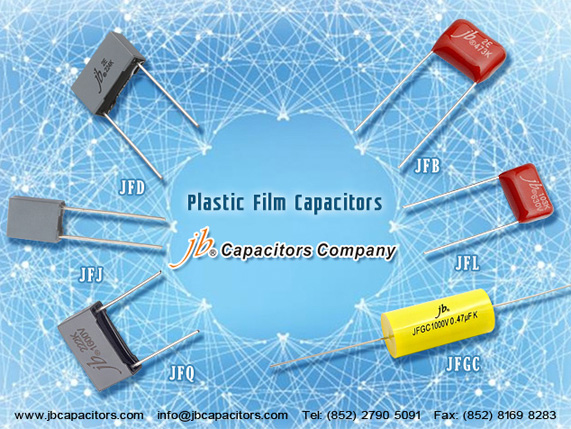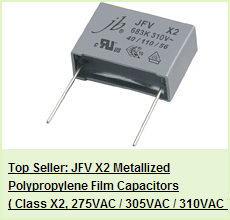2010-12-21 1:25:31
views
Below is some information for current our most popular items, are you still interested in?
If you need faster lead time 7-9 weeks, welcome to check our JFE series, MKT dipped type, also with P:5mm.
JFJ--Mini Box Type, 5mm pitch size, stacked. MKT polyester film capacitors
Cross Arcotronics (Kemet) R82, Epcos B32529, Vishay MKT370,MKT365-367
Datasheet: http://www.jbcapacitors.com/pdf/JFJ-Mini-Box-Stacked-Metallized-Polyester-Film-Capacitor.pdf
Packing: Bulk & Ammo Pack
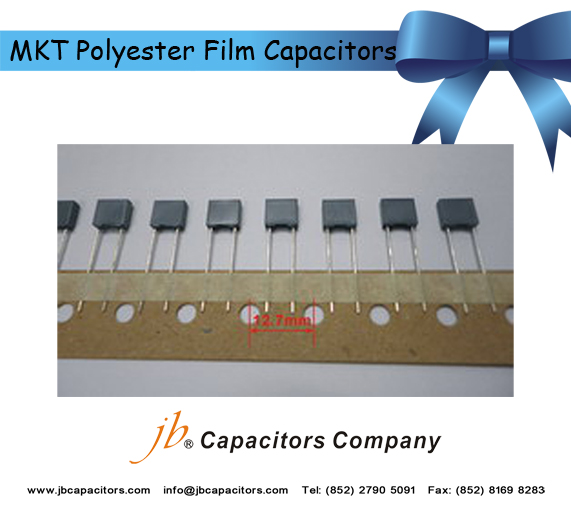
2010-12-18 2:45:16
views
A capacitor is a passive electronic component that stores energy in the form of an electrostatic field. In its simplest form, a capacitor consists of two conducting plates separated by an insulating material called the dielectric. Capacitance is directly proportional to the surface areas of the plates, and is inversely proportional to the plates' separation.
Capacitance also depends on the dielectric constant of the dielectric material separating the plates.
The standard units of Capacitance,
farad: F
microfarad: µF (1 µF = 10-6 F)
nanofarad: nF (1 nF = 10-9 F)
picofarad: pF (1 pF = 10-12 F)
For any good capacitors, welcome to find us.jb can help you in this regards.
2010-12-17 2:29:32
views
Capacitors naturally wear out after extended periods of use. Most capacitors are designed to operate for several thousand hours. Here is the projected lifespan for a typical capacitor, rated for 4,000 hours of operation at an average core temperature of 167 degrees Fahrenheit (75℃).
| Core temperature in degrees F (and ℃) | Projected lifespan in hours of operation |
| 221(105) | 500 |
| 203(95) | 1,000 |
| 185(85) | 2,000 |
| 167(75) | 4,000 |
| 149(65) | 8,000 |
| 131(55) | 16,000 |
| 113(45) | 32,000 |
2010-12-16 15:7:24
views
Capacitors on a motherboard are used to absorb spikes in electrical current and to smooth the flow of power on the motherboard, protecting all of the computer’s components.
Contact our jb, as we are manufacturer of these capacitors and you also contact us if you have technical questions regarding these parts. jb (www.jbcapacitors.com) is a good place to find good capacitors. Our salesman is available to your e-mailed at info@jbcapacitors.com.
2010-12-15 11:55:6
views
Film Capacitors are distinguished by their extreme reliability. They are principally used in power supplies for telecom equipment, domestic appliances and entertainment electronics. Energy-saving and environmentally friendly lighting would be inconceivable without Film Capacitors. They are also essential to high-speed Internet access.
jb Capacitors produce Metallized Polyester Film Capacitor since 1980. Metallized Polyester Film Capacitor is one of the most common series of Film Capacitors, we sell high quality with very competitive prices in the market. Following are Metallized Polyester Film Capacitor specifications.
| Metallized Film Capacitors: |  |
| Operating Temperature: -40℃~+85℃ |
| Voltage Rating: 250V.AC |
| Capacitance Range: 0.01~4.7μF |
| Capacitance Tolerance: ±5%,±10%,±20% |
| Pitch size: 10,15,20,22.5,26.5,31.5,31mm |
2010-12-14 12:12:35
views
Aluminum Electrolytic Capacitors are used in frequency converters, switch-mode power supplies, power converters, uninterruptible power supplies and electronic flash units for studio photography. They are distinguished by high volumetric capacitance and outstanding current-handling capability.
jb Capacitors, founded in 1980 in Taiwan, has long history on producing full series of Plastic Film Capacitors and snap-in, screw, lug Aluminum Electrolytic Capacitors. Compared with other competitors, we offer top quality products with very competitive price. Also, our products are RoHS compliant and SGS certification.
Type: Aluminum Electrolytic Capacitors
Specification:
Load life of 2000 hours at 85℃ and 105℃
Hight ripple current
Smaller size
PCB Mounting
Series:
Snap in type,85℃. for speaker network
Sanp in type,105℃, miniaturized
Snap in type,85℃, general miniaurized, long life
Snap in type,105℃,miniaturized,long life
Screw type,85℃,long life
Screw type,85℃,general, life
Screw type,85℃,miniaturized
Lug type,for photo flash
Lug type, for motor starting
2010-12-13 14:38:15
views
Voltage to Current Convertor
When driving the input (base) of a transistor gain stage:
you must convert the input voltage to a current by using a voltage to current convertor --a resistor.
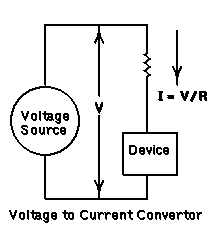
Current to Voltage Convertor
When deriving a voltage from the collector of a transistor amplifier stage:
you convert the output (collector) current into a voltage by using a Current to Voltage convertor in the collector circuit--you guessed it--a resistor.
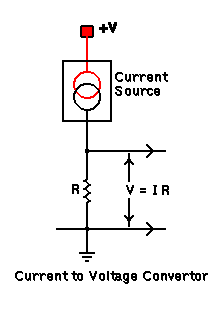
2010-12-11 14:35:17
views
Along with the high integration of semiconductor devices, the miniaturization of their components has also advanced. For a dynamic random access memory (DRAM), a high-capacity capacitor with small size is required. Ferroelectric thin film capacitors with extremely large relative permittivity have been developed for this purpose. In film capacitors, the dielectric in such film capacitors comprises a plastic film. The electrodes comprise conductive metal areas. These metal areas are either thin conductor films or conductor layers vapor-deposited onto the plastic film. Thin-film capacitor devices generally comprise a substrate and a lower electrode, a dielectric layer, and an upper layer which are deposited on the substrate in that order. Thin-film capacitors also have a semiconductor substrate functioning as a lower electrode and have a dielectric layer and an upper layer which are deposited on the semiconductor substrate in that order in some cases.
2010-12-10 12:31:0
views
Polarized fixed capacitor 
A polarized ("polar") capacitor is a type of capacitor that have implicit polarity -- it can only be connected one way in a circuit. The positive lead is shown on the schematic (and often on the capacitor) with a little "+" symbol. The negative lead is generally not shown on the schematic, but may be marked on the capacitor with a bar or "-" symbol. Polarized capacitors are generally electrolytics.
Note that you really need to pay attention to correctly hooking a polarized capacitor up (both with respect to polarity, as well as not pushing a capacitor past its rated voltage). If you "push" a polarized capacitor hard enough, it is possible to begin "electrolyzing" the moist electrolyte. Modern electrolytic capacitors usually have a pressure relief vent to prevent catastrophic failure of the aluminum can (but don't bet your eyesight on this).

